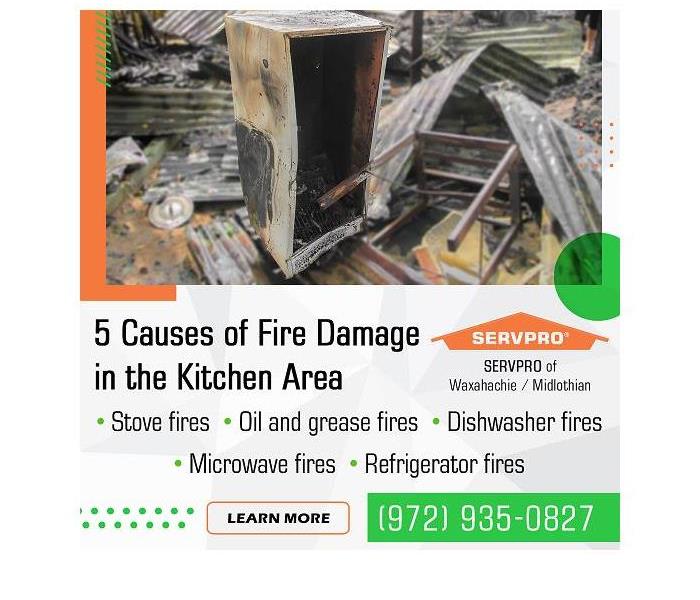Five Kitchen Fire Hazards That Can Cause a Fire Damage Disaster
7/2/2021 (Permalink)
Blog Summary: To help homeowners avoid fire damage in the kitchen, SERVPRO of Waxahachie / Midlothian warns people about fire hazards involving the stove, microwave, refrigerator, and dishwasher.
Years of experience responding to kitchen fires and other fire damage disasters have given the fire damage restoration team at SERVPRO of Waxahachie / Midlothian great compassion for people affected by fire damage. A fire in the kitchen can be a frightening and devastating experience for homeowners and their families. One moment the family is enjoying the rich, complex aromas of a lovingly prepared meal; the next moment smoke and the smell of burnt food fill the kitchen as smoke alarms screech in a deafening clamor of high-pitched peals. To help homeowners prevent a disaster from occurring in their kitchen, SERVPRO of Waxahachie / Midlothian is highlighting five causes of fire damage in the kitchen area.
- Stove fires
Leaving the stovetop unattended is a major cause of fire damage in the kitchen. If the chef does not keep a careful watch on the stove, food can quickly become overheated and catch fire, engulfing the kitchen in a conflagration.
Another stovetop safety hazard is the failure to keep the area around the stove clean and free of flammable materials. A cluttered or dirty counter around the stove is an invitation for a small stovetop fire to spiral out of control.
- Oil and grease fires
Oil and grease are notorious for their flammable properties, and anyone who decides to use these cooking methods should exercise great caution. Home cooks must learn how to properly deal with an oil and grease fire in order to prevent personal injury and fire damage.
The National Fire Protection Association (NFPA) shares the following recommendations for safely cooking with oil or grease: “Keep an eye on what you fry. If you see wisps of smoke or the oil smells, immediately turn off the burner and/or carefully remove the pan from the burner. Smoke is a danger sign that the oil is too hot. Heat the oil slowly to the temperature you need for frying or sautéing. Add food gently to the pot or pan so the oil does not splatter.”
- Microwave fires
Microwave fires can ignite in a variety of ways. Beware of overheating foods or inputting the wrong heating time into the microwave. Homeowners can easily prevent this mistake by quickly checking the microwave countdown to ensure that their food is heating for forty seconds, not four minutes.
Arcing, also known as sparking, is a fire hazard in microwaves that are malfunctioning or defective. In 2016, Good Housekeeping reported that Whirlpool, a home appliance company, had to recall over 15,000 microwaves because the appliances posed a potential fire hazard due to arcing. According to Good Housekeeping, “Whirlpool received five reports of fire incidents, including one home fire, two fires involving surrounding cabinets, one report of smoke and another of burning odor.”
Heating food in dishes or containers that are not microwave-safe also poses a fire risk. The National Institutes of Health provides the following advice: “Remove food from packaging before defrosting in a microwave oven. Do not use plastic storage containers, foam trays, and plastic wraps in microwave ovens because they are not heat-stable at high temperatures. Melting or warping can occur which may cause harmful chemicals to migrate into the food. Never use recycled paper products in microwave ovens unless they are specifically approved for microwave use. Some recycled products including paper towels and even waxed paper may contain minute metal flecks. When a microwave oven is operating, the interaction between microwaves and the metal can cause sparks and even flames.”
- Refrigerator fires
It may surprise homeowners to learn that the refrigerator is a leading cause of fires in the kitchen after the stove and microwave. While the purpose of refrigerators and freezers is to keep things cool, the electrical components in these appliances give them the potential to make things hot.
Consumer Reports elaborates on refrigerator fire damage statistics: “From 2006 to 2010, the latest statistics available for the U.S., refrigerators and freezers were the cause of 1,710 home structure fires that resulted in two deaths, 19 injuries, and $23 million in property damage. Typically the fires were caused by the relay switch short-circuiting or the lightbulb remaining on when the door was closed, according to the U.S. Fire Administration’s National Fire Incident Reporting System.”
- Dishwasher fires
The dishwasher is another unexpected cause of kitchen fires and should be regarded as a potential fire hazard. Dishwashers rely on heating elements to clean and dry the dishes, and these elements can turn into a fire hazard when they become old and worn out. As a precaution, never leave the dishwasher running when no one is at home.
The fire hazards in a kitchen are not always obvious sources of fire damage. What is obvious is the need for a trustworthy and reliable damage restoration company in the aftermath of a kitchen fire. SERVPRO of Waxahachie / Midlothian is proud to serve the local community with damage restoration services, including fire and smoke damage restoration services, that instill confidence and give hope to homeowners in need.
To learn more about fire damage restoration in Midlothian, TX, call SERVPRO of Waxahachie / Midlothian at (972) 935-0827 or email the company at acarey@SERVPRO10932.com.



 24/7 Emergency Service
24/7 Emergency Service
